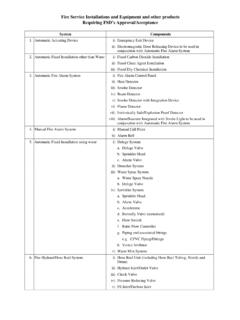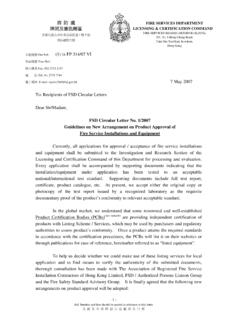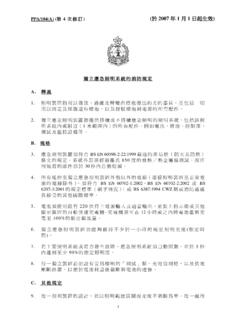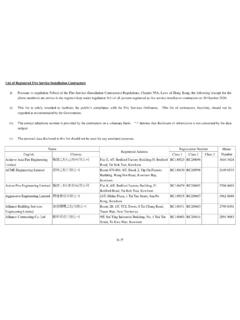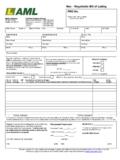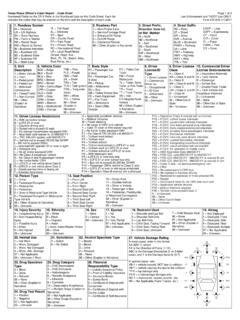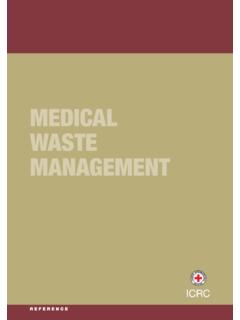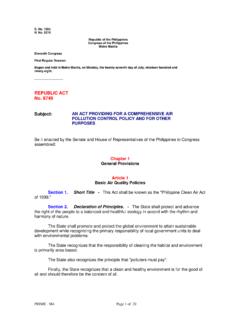Transcription of DANGEROUS GOODS - HKFSD
1 FIRE PROTECTION NOTICE DANGEROUS GOODS ( 295 ) DANGEROUS GOODS Ordinance (Chapter 295) 2016 4 April 2016 Rev. (4/2016) 1 FIRE PROTECTION NOTICE NO. 4 DANGEROUS GOODS SECTION 3 of the DANGEROUS GOODS Ordinance, Cap 295 declares the following to be DANGEROUS GOODS : All explosives, compressed gases, petroleum and other substances giving off inflammable vapours substances giving off poisonous gas or vapour, corrosive substances, substances which become DANGEROUS by interaction with water or air, substances liable to spontaneous combustion or of a readily combustible nature. SECTION 6 of the Ordinance states: Except under and in accordance with a licence granted under this Ordinance no person shall manufacture, store, convey or use any DANGEROUS GOODS .
2 1. The above that with the exception of Explosives (Category 1 DANGEROUS GOODS ) which can only be manufactured or stored as required by the Commissioner of Mines, other categories of DANGEROUS GOODS can only be used and/or stored in excess of their statutory exempt quantity in accommodation approved and licensed by the Director of Fire Services. 2. conveyance A licence issued by the Director of Fire Services is required for any vehicle used for the conveyance of Category 2 or Category 5 DANGEROUS GOODS exceeding its exempt quantity. 3. Containers, capacities and labels Attention is drawn to various tables in the DANGEROUS GOODS (General) Regulations, Cap 295B in relation to approved containers, capacities and labels required. Examples of labels are included at the end of this Notice.
3 Provided that, where any inner packing of any substance except Category 2 DANGEROUS GOODS has already been conspicuously marked in English and Chinese in such manner as to indicate the nature of DANGEROUS GOODS , nothing in this paragraph shall be construed to require the substitution therefor, or the addition thereto, of any label prescribed at the end of this Notice. Rev. (4/2016) 2 4. Removal and seizure Fire Officers may require any DANGEROUS GOODS being manufactured, stored, conveyed or used in any way in contravention of the DANGEROUS GOODS Ordinance and its subsidiary legislation to be removed at the owner s expense to such a place which is in conformity with the Ordinance. Alternatively, the officer may seize and remove such GOODS .
4 5. Listing This Notice contains an alphabetically listed index of all DANGEROUS GOODS listed in the DANGEROUS GOODS (Application and Exemption) Regulations, Cap 295A, with the exception of Category 1 (Explosives and blasting agents) in respect of which the Authority is the Commissioner of Mines. Rev. (4/2016) 3 6. Classification Pursuant to the DANGEROUS GOODS (Application and Exemption) Regulations, Cap 295A, DANGEROUS GOODS are classified into the following categories: Category 1: Explosives and blasting agents (The Authority is the Commissioner of Mines) Category 2: * Compressed gases Class 1 Permanent gases Class 2 Liquefied gases Class 3 Dissolved gases Category 3: Corrosive substances Category 4: Poisonous substances Class 1 Substances giving off a poisonous gas or vapour Class 2 Certain other poisonous substances Category 5.
5 * Substances giving off inflammable vapour Class 1 Flash point below 23oC Division 1- immiscible with water Division 2 - miscible with water Class 2 Flash point of or exceeding 23oC but not exceeding 66oC Division 1 - immiscible with water Division 2 - miscible with water Class 3 Flash point of or exceeding 66oC (diesel oils, furnace oils and other fuel oils only) Category 6: Substances which become DANGEROUS by interaction with water Category 7: Strong supporters of combustion Category 8: Readily combustible substances Category 9: Substances liable to spontaneous combustion Category 9A: Combustible GOODS Category 10: Other DANGEROUS substances * Rider clauses ( catch-all provisions) are provided for Category 2 and Category 5 DANGEROUS GOODS to include any other substances having similar properties but not yet specified in the list.
6 Rev. (4/2016) 4 7. Potable spirits (Category 5 DANGEROUS GOODS ) "Potable spirit" means any spirit being miscible with water, other than denatured spirits as defined in section 53 of the Dutiable Commodities Ordinance (Cap 109), containing more than 35% of ethyl alcohol by volume and having a flash point of or exceeding 23 oC but not exceeding 66 oC. The exempt quantities of potable spirits are:- (1) For transport only, any quantity not exceeding 12 500 L in the aggregate. (2) For storage only (a) any quantity not exceeding 12 500 L in the aggregate when packed in individual receptacles not exceeding a capacity of 5 L and stored or used in premises protected throughout by automatic sprinkler installations; (b) any quantity not exceeding 6 250 L in the aggregate when packed in individual receptacles not exceeding a capacity of 5 L and stored or used in premises not protected throughout by automatic sprinkler installations; (c) any quantity not exceeding 2 500 L in the aggregate when packed in individual receptacles exceeding a capacity of 5 L and stored or used in any premises.
7 8. Category 9A combustible GOODS (exempted from Section 6 to 11 of Cap 295) This table lists the maximum quantity of Category 9A combustible GOODS in the following types of premises: (a) Premises forming part of a building in which other premises are used for residential purposes or otherwise than for the purpose of an industrial undertaking; (b) Buildings used exclusively for purposes of industrial undertakings. The person in control of such premises or place shall, within 48 hours, send a notice in writing to the Director of Fire Services in respect of the details of storage if the total storage quantity is in excess of these quantities as stipulated below: Rev. (4/2016) 5 TABLE Type of premises Combustible GOODS (a) (b) Cotton (raw) 50 kg 2 tonnes Kapok 50 kg 2 tonnes Cotton waste 100 kg 2 tonnes Matches 30 kg 500 kg Polytetrafluoroethylene 250 kg 2 tonnes Polythene, raw material 250 kg 2 tonnes Polystyrene, raw material 250 kg 2 tonnes Polyvinyl Chloride, raw material 250 kg 2 tonnes Polymethylmethacrylate, raw material 250 kg 2 tonnes Polypropylene, raw material 250 kg 2 tonnes Rubber, raw 100 kg 2 tonnes Rubber tyres, motor 50 tyres 500 tyres Rev.
8 (4/2016) 6 9. Prohibited GOODS SECTION 7 of the Ordinance states: No person shall manufacture or cause to be manufactured any prohibited GOODS or have any prohibited GOODS in his possession, custody or control or in the possession, custody or control of any servant, agent or warehouse owner. The following GOODS are declared as prohibited GOODS : Ammonium Permanganate Ammonium Chlorate Ammonium Nitrate, if containing organic matter otherwise than of a nature and within a limit approved, either generally or in any particular case, by the Authority Arsine, except when it is contained in cylinders not exceeding 1 m3 in volume at Standard Temperature and Pressure and of a type approved by the Authority, and is brought into Hong Kong exclusively for electronic production processes within Hong Kong, and is stored and used in licensed premises within a limit approved, either generally or in any particular case, by the Authority Calcium Azide.
9 Except in aqueous solution not exceeding 20% of Calcium Azide by weight Chloric Acid solutions of strength greater than 10% by weight Hydrazine Nitrate Hydrazine Perchlorate Hydrogen Cyanide, unstabilized Hydrogen Peroxide solutions of strength greater than 60% by weight Manufactured fireworks ( , , ) which explode on impact Organic Perchlorates Perchloric Acid solutions of strength greater than 72% by weight Vinyl Chloride Monomer Rev. (4/2016) 7 10. Legal obligation Persons who are involved with the manufacture, storage, use or conveyance of DANGEROUS GOODS have a legal responsibility to ensure that none of the licensing requirements and the provisions of the DANGEROUS GOODS Ordinance and its subsidiary legislation are violated. Licensees should be conversant with the provisions of the DANGEROUS GOODS Ordinance and its subsidiary legislation as applicable to the particular DANGEROUS GOODS being manufactured, stored, used or conveyed.
10 Public can access the contents of the legislation through the Bilingual Laws Information System of the Department of Justice via the following website: 11. Common offences Complaints received and routine inspections concerning DANGEROUS GOODS carried out indicate the following common contraventions against the DANGEROUS GOODS Ordinance and its subsidiary legislation: (a) Storage, conveyance or use of DANGEROUS GOODS in excess of its statutory exempt quantity without a valid DANGEROUS GOODS licence; (b) Storage of DANGEROUS GOODS of a category different from the category of the licensed store in which they are placed; (c) Storage of different categories of DANGEROUS GOODS in the same store; (d) Storage of DANGEROUS GOODS with other general GOODS in licensed DANGEROUS GOODS stores; (e) Storage of DANGEROUS GOODS in excess of its statutory exempt quantity on open ground (unlicensed areas).

